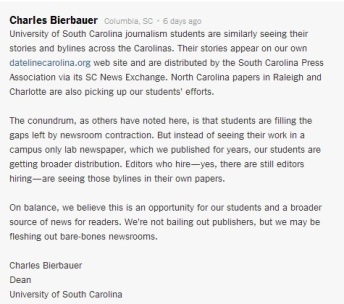A recent article by the New York Times revealed that student journalists at the University of Michigan cracked a story before any other local publication. Other publications, at Arizona State University, University of Wisconsin-Madison and Harvard University, have reported breaking stories or have developed methods of embedding reporters for local news.
The New York Times transitioned the story into a larger discussion about how student journalists are providing better coverage of local news in some instances than the for-pay local newspapers. The NYT reported that comparatively there are 1,800 American college and university newspapers and only 1,380 daily newspapers left in the United States. Now, while I love an underdog story just as much as anyone else, I find that this article makes a couple stretches. And boy, do the comments call them out both on Twitter and on the NYT site.
But here are a few statements or questions I still have for the reporter:
- Many locals are no longer dailies. Does that mean they are unable to cover breaking news? Not necessarily.
- Many college newspapers, small and large, produce local news coverage that sometimes the local press misses. Especially if that news is on-campus!
- If this is the case, should students stay in college forever to keep reporting the news that local newspapers don’t report and aren’t hiring for?
- Does this mean anything for the future of news coverage?
- Is student journalists’ local news coverage indicative of greater civic engagement?
These final two questions are quite exciting and nerve wracking for young journalists looking to enter into the journalism workforce.
University of Michigan’s Michigan Daily is run by editor-in-chief, Peter Shahin. He told the NYT that the student paper has a better idea of the town than other newspapers in surrounding areas because of their resources through the university:
I feel The Michigan Daily fills an important niche in Ann Arbor and a need that is unmet by our regional newspapers in an era of constrained resources…We have 200 to 250 staff, and though we are a trade publication first covering the university, we are also trying to fill a void in other areas here, like the arts…I think we truly have the pulse of the town.
Journalism students have the potential to report local news just as much as a local news organization does, except for the fact that they report to a tailored audience. Student media has the potential to be the voice of a significant population that could promote more civic engagement. This is true at least among the journalists.
This week, Peter Bobkowski, University of Kansas assistant professor of journalism, decided its time to find out if the connection exists. The University of Kansas, KU News Service reported that Bobkowski is looking for a connection between civic engagement and high school journalism in Kansas to pave the way for future journalism education:
If there is a connection, I think the study will help legitimize journalism education to principals and administrators, showing that journalism is not just about writing about the latest music or the homecoming dance…It’s about learning skills students can use to carry forward in their civic lives.
While college journalism is expanding and finding new ways to attract audience, local newsrooms and city newspapers still provide local coverage. All of this is status quo, but journalism with any adjective before it, should be something the public is thankful for in that ultimately, it provides a public service.
It’s all about changing the communication gap.
Journalism sophomore Peyton Gallovich at Arizona State University (no I don’t go there, and no I didn’t want to reference them twice so their PR must be really effective online) created a Deaf and Hearing Network of vocal news, signed-only news and news with subtitles, she told ASU’s student newspaper, Downtown Devil. She hopes ultimately that this station will be run by deaf people.
“I see this need, and I think that I can fill it,” Gallovich said to the Downtown Devil. “So, I got together with people who thought this was a necessary thing too, and here we are.”
Or as Dan Kennedy quoted in his article in 2013 on his book The Wired City, which discussed coverage of local communities by looking at readership primarily and building an audience, Howard Owens said it better:
…local community news is currently only a niche product. Entrepreneurs need to think about not only “how am I going to appeal to the people who care now,” but “how am I going to get more people to care about their community so I can grow my audience?”
Isn’t that what all journalism is about? Filling the need for information as a public service and educating people along the way? Hopefully this study finds that journalists are being educated in high school to educate others. And college students are doing the job of local newspapers to instill life in the local community. And even that journalists are providing new ways to look at information.
This isn’t just for college students and this isn’t just about their education. It’s about civic engagement for all young people, and a new media that can bring new audiences into it.
Journalists are the future of journalism, and the NYT is stating the obvious because college journalists are still journalists. This is the status quo.
What do you think? Are college journalists the future of journalism?








